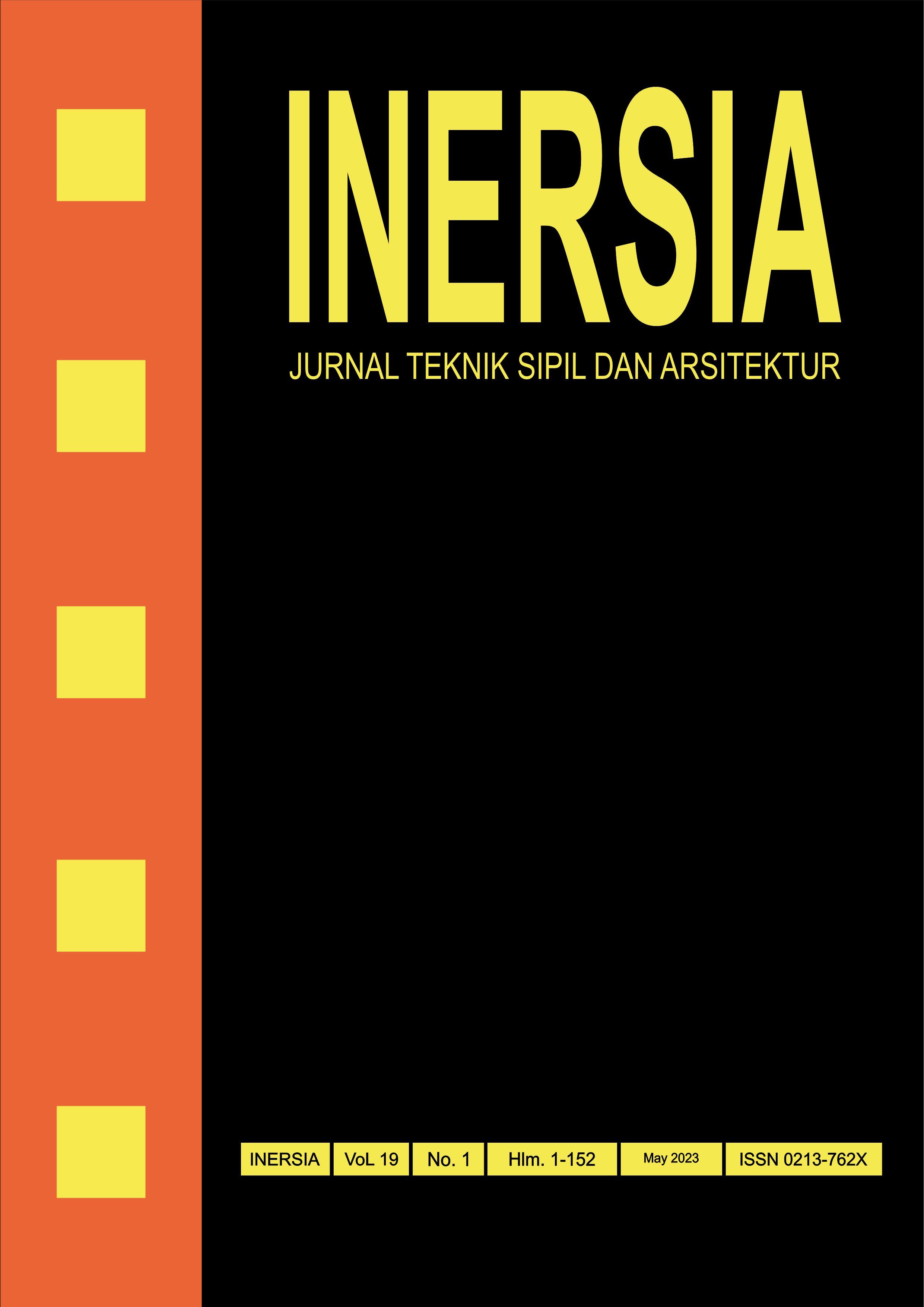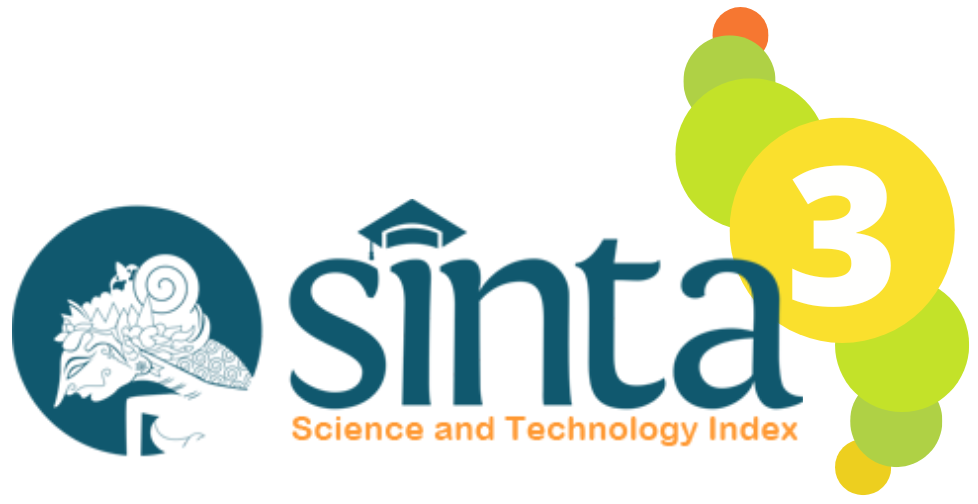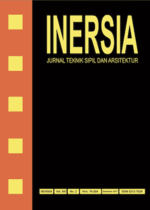Comparation Study of Wood Quality Influenced by Water Content with Ultrasonic Pulse Velocity Test Approach
DOI:
https://doi.org/10.21831/inersia.v19i1.60759Keywords:
Wood Quaility, Ultrasonic Pulse Velocity (UPV), Water contentAbstract
In general, the building evaluation requires a sample from the building being tested. However, this cannot be done in cultural heritage buildings such as Masjid Gedhe Mataram. Because of that reason, an Ultrasonic Pulse Velocity test (UPV) is applied. This test aims to determine the strength of the wood quality due to the influence of its water content using the ultrasonic pulse velocity direct method. In the UPV test, the results are in the form of wave propagation which is influenced by several factors such as the type and the water content of the wood. There were 3 types of tested wood, 9 specimens each. The types of tested wood were kruing (KR), sengon (S), and teak wood (JTB). The water content was set at 12%, 15%, 20%, 25%, and 30%.
The results showed a strong correlation between MoE and MoEd values of kruing wood with an R2 value of 0.8405, a weak correlation of sengon wood with an R2 value of 0.31, and a strong correlation of teak wood with an R2 value of 0.9331. The differences in wood quality based on modulus of elasticity between bending testing and UPV were 0.9 - 4.43% for kruing wood, 3.23 - 23.4% for sengon wood, and 3.4 - 33% for teak wood.
References
E. Setyowati, G. Hardiman, and T. W. Murtini, "Cultural Acculturation in the Mataram Mosque Building, Yogyakarta," no. April, pp. A011–A018, 2017, doi: 10.32315/sem.1.a011.
D. Darmono, M. S. Nugroho, S. Widodo, and F. Ma'arif, "Analysis Of Decreasing Wood Quality In Cultural Heritage Building Using The Non-Destructive Test Method (Case Study of the Mosque Cultural Heritage Building, Mataram, Special Region of Yogyakarta)," INERSIA lnformasi dan Ekspose Has. Ris. Tek. Sipil dan Arsit., vol. 16, no. 2, pp. 191–199, Dec. 2020, Accessed: May 29, 2023. [Online]. Available: https://journal.uny.ac.id/index.php/inersia/article/view/36905
William D Callister et al, Materials Science and Engineering, 10th ed. 2018. Accessed: May 30, 2023. [Online]. Available: https://ftp.idu.ac.id/wp-content/uploads/ebook/tdg/Teknologi Rekayasa Material Pertahanan/Materials Science and Engineering An Introduction by William D. Callister, Jr., David G. Rethwish (z-lib.org).pdf
BSN, SNI 03-3959-1995 Methods for testing the flexural strength of wood in the laboratory. 1995, pp. 1–9.
X. Arzola-Villegas, R. Lakes, N. Z. Plaza, and J. E. Jakes, "Wood moisture-induced swelling at the cellular scale"”ab intra," Forests, vol. 10, no. 11, p. 996, Nov. 2019, doi: 10.3390/f10110996.
D. A. L. Silva, F. A. R. Lahr, O. B. De Faria, and E. Chahud, "Influence of wood moisture content on the modulus of elasticity in compression parallel to the grain," Mater. Res., vol. 15, no. 2, pp. 300–304, 2012, doi: 10.1590/S1516-14392012005000025.
ASTM D4442-16, "Standard Test Methods For Direct Moisture Content Measurement Of Wood And Wood-Base Materials," Annu. B. ASTM Stand., vol. 4, no. 10, pp. 1–6, 2016.
ASTM D729, Standard Test Methods for Density and Specific Gravity (Relative Density) of Plastics by Displacement. 2008, p. 6. doi: 10.1520/D2395-17.2.
L. Karlinasari, S. Suljokusumo, N. Nugroho, and Y. S. Hadi, "Non-Destructive Testing of Three Indonesian Plantations Wood Beam," J. Teknol. Has. Hutan, Fak. Kehutan. IPB, vol. 19, 2006.
BSN, SNI ASTM C597:2012 Test method for speed of wave propagation through concrete. 2012, pp. 1–10.
P. R. A. Smith, "Non-Destructive Testing (NDT) – Guidance Document: An Introduction to NDT Common Methods," Br. Inst. NDT, no. 2, p. 159, 2015, [Online]. Available: http://www.bindt.org/admin/Downloads/Apprenticeship-Guidance-Document.pdf
W. Products, W. Materials, and H. M. Meters, "D4761-11 Standard Test Methods for Mechanical Properties of Lumber and Wood-Base Structural Material," vol. i, no. 1, pp. 1–10, 2011.
Downloads
Published
How to Cite
Issue
Section
License
Authors who publish with INERSIA journal agree to the following terms:
- Authors retain copyright and grant the INERSIA journal right of first publication with the work simultaneously licensed under Creative Commons Attribution License (CC BY 4.0) that allows others to share the work with an acknowledgment of the work's authorship and initial publication in this journal.
- Authors can enter into separate, additional contractual arrangements for the non-exclusive distribution of the published version of the work (e.g., post it to an institutional repository or edit it in a book), with an acknowledgment of its initial publication in this journal.
- Authors are permitted and encouraged to post their work online (e.g., in institutional repositories or on their website) before and during the submission process, as it can lead to productive exchanges, as well as earlier and greater citation of published work.

INERSIA by https://journal.uny.ac.id/index.php/inersia was distributed under a Creative Commons Attribution 4.0 International License











